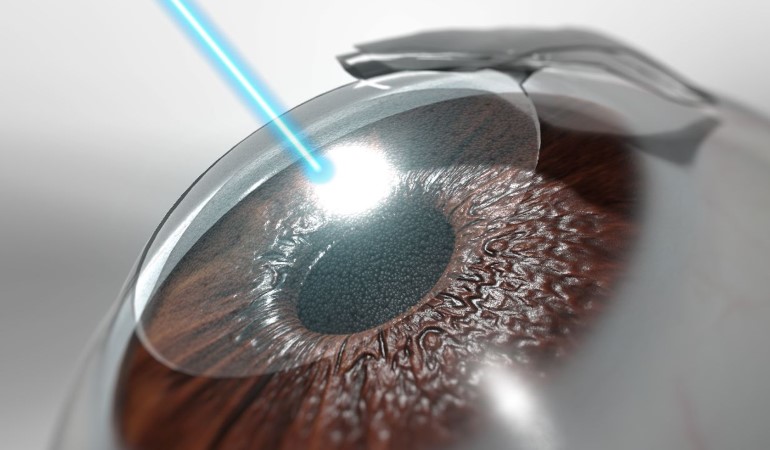Refractive Surgery

Refractive Surgery
Refractive surgery is a type of surgery that corrects vision problems by changing the shape of the cornea, the clear front part of the eye. It can be used to correct nearsightedness (myopia), farsightedness (hyperopia), and astigmatism.
There are different types of refractive surgery, including:
• Femto-LASIK LASIK is a type of LASIK surgery that uses a femtosecond laser to create the flap in the cornea. This is in contrast to traditional LASIK, which uses a blade to create the flap.
It’s two-step procedure. In the first step, the surgeon creates a thin flap in the cornea using femtosecond laser. In the second step, the surgeon uses another laser to reshape the underlying corneal tissue. The surgeon then will return the corneal flap into its original position.
It is very effective and safe procedure, and it is one of the most popular types of refractive surgery performed today
Femto-LASIK is a type of LASIK surgery that uses a femtosecond laser to create the flap in the cornea. This is in contrast to traditional LASIK, which uses a blade to create the flap.
Femto-LASIK is considered to be a more precise and accurate method of creating the flap than traditional LASIK. This is because the femtosecond laser can create a thinner and more uniform flap. A thinner flap is less likely to cause complications, such as dry eyes and glare.
Femto-LASIK is a two-step procedure. In the first step, the surgeon uses a femtosecond laser to create a thin flap in the cornea. This flap is then folded back, exposing the underlying corneal tissue. In the second step, the surgeon uses an excimer laser to reshape the corneal tissue. The flap is then replaced.
Femto-LASIK offers a number of benefits, including:
• Improved vision: Femto-LASIK can significantly improve vision, and many people are able to achieve 6/6 vision or better after surgery
• Reduced or eliminated need for glasses or contact lenses: Femto-LASIK can reduce or eliminate the need for glasses or contact lenses. This can be a major convenience and improve quality of life.
• Quick recovery: It is a minimally invasive procedure, and most people are able to return to their normal activities within a few days.
• Femto-LASIK is a good option for most people who are 18 years of age or older and have healthy eyes. However, it may not be suitable for everyone. For example, people with thin corneas, certain eye diseases, or pregnant or breastfeeding women are not good candidates for Femto-LASIK.
• PRK stands for photorefractive keratectomy. PRK is a one-step procedure. The surgeon uses a laser to reshape the outer surface of the cornea.
PRK (photorefractive keratectomy) is a laser eye surgery that corrects refractive vision errors by changing the shape of the cornea.
PRK works by using an excimer laser to remove a small amount of tissue from the corneal stroma, the middle layer of the cornea. The laser is programmed to remove tissue in a precise pattern, which changes the shape of the cornea and allows it to bend light correctly.
PRK is an effective treatment for myopia (nearsightedness), hyperopia (farsightedness), and astigmatism. It is also a good option for people who have thin corneas or who are not good candidates for LASIK (laser-assisted in-situ keratomileusis), another type of laser eye surgery.
You will be given numbing eye drops and a sedative to help you relax. Your epithelium — the outer layer of your cornea — will be removed using laser or mechanically by an alcohol solution. The surgeon will then use laser to reshape your cornea. A bandage contact lens is usually placed at the end of surgery to reduce irritation during the healing process.
PRK recovery is typically longer than LASIK recovery. It can take several weeks or even months for your vision to fully stabilize. During this time, you may experience blurred vision, discomfort, and light sensitivity. You will also need to use eye drops and avoid activities that could irritate your eyes, such as swimming and rubbing your eyes.
• Femto-SMILE: SMILE stands for small incision lenticule extraction. SMILE is a newer type of refractive surgery that is similar to LASIK. However, SMILE does not require a flap to be created in the cornea.
• ICL: ICL stands for implantable collamer lens. ICL is a type of lens that is implanted inside the eye to correct vision problems. ICL is a good option for people with thin corneas or severe vision problems.
• RLE: RLE stands for refractive lens exchange. RLE is a type of surgery that replaces the natural lens of the eye with an artificial lens. RLE is a good option for people with cataracts or severe vision problems.